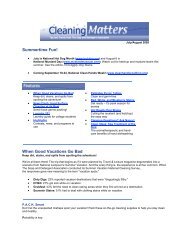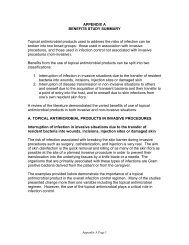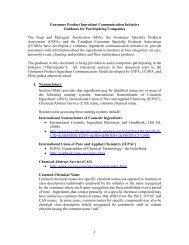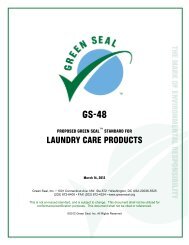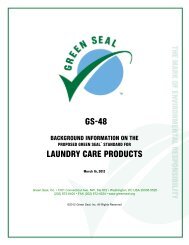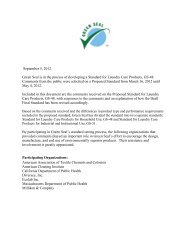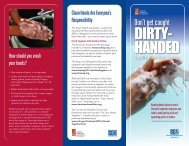subchapter c -- federal hazardous substances act regulations
subchapter c -- federal hazardous substances act regulations
subchapter c -- federal hazardous substances act regulations
Create successful ePaper yourself
Turn your PDF publications into a flip-book with our unique Google optimized e-Paper software.
valve and ignite the pilot and test flames.<br />
Adjust the test flame with the pinch valve to<br />
conform to the size of the 4-mm ( 5 ⁄ 32 -in.) gage.<br />
(iii) After the audible time signal indicates<br />
the specimen is at test temperature 10 , apply the<br />
test flame by slowly and uniformly opening<br />
the shutter and then closing it completely over<br />
a period of approximately 2 1 ⁄ 2 s. Watch closely<br />
for a flash at the cup opening.<br />
(iv) The sample is deemed to have flashed<br />
only if a large flame appears and<br />
instantaneously propagates itself over the<br />
surface of the sample. (See § 1500.43a(c).)<br />
(v) Turn off the pilot and test flames using<br />
the gas control valve. When the cup<br />
temperature declines to a safe level, remove<br />
the sample and clean the instrument.<br />
(5)(i) If a flash was observed in §<br />
1500.43a(j)(4)(iii) repeat the procedure given<br />
in § 1500.43a(j)(2) or (3), and in §<br />
1500.43a(j)(4), testing a new specimen at a<br />
temperature 5 °C (9 °F) below that at which<br />
the flash was observed.<br />
(ii) If necessary, repeat the procedure in §<br />
1500.43a(j)(5)(i), lowering the temperature 5<br />
°C (9 °F) each time, until no flash is<br />
observed.9<br />
(iii) Proceed to § 1500.43a(j)(7).<br />
(6)(i) If no flash was observed in §<br />
1500.43a(j)(4)(iii) repeat the procedure given<br />
in § 1500.43a(j)(2) or (3), and in §<br />
1500.43a(j)(4), testing a fresh specimen at a<br />
temperature 5 °C (9 °F) above that at which<br />
the specimen was tested in §<br />
1500.43a(j)(4)(iii).<br />
(ii) If necessary repeat the procedure in §<br />
1500.43a(j)(6)(i), above, raising the<br />
temperature 5 °C (9 °F) each time until a flash<br />
is observed.9<br />
(7) Having established a flash within two<br />
temperatures 5 °C (9 °F) apart, repeat the<br />
procedure at 1 °C (2 °F) intervals from the<br />
lower of the two temperatures until a flash is<br />
observed.9 Record the temperature of the test<br />
when this flash occurs as the flashpoint,<br />
allowing for any known thermometer<br />
correction. Record the barometric pressure.4<br />
(8) The flashpoint determined in §<br />
1500.43a(j)(7) will be to the nearest 1 °C (2<br />
the temperature to rise under ambient conditions<br />
until the temperature reaches 5 °C (9 °F) below the<br />
expected flashpoint. Immediately apply the test<br />
flame.<br />
16 CFR Ch. II (1–1–05 Edition)—proposed modificication – 6/25/06<br />
-- 45 --<br />
°F). If improved accuracy is desired (that is, to<br />
the nearest 0.5 °C (1 °F)), test a fresh<br />
specimen at a temperature 0.5 °C (1 °F) below<br />
that at which the flash was observed in §<br />
1500.43a(j)(7). If no flash is observed, the<br />
temperature recorded in §1500.43a(j)(7), is the<br />
flashpoint to the nearest 0.5 °C (1 °F). If a<br />
flash is observed at the lower temperature,<br />
record this latter temperature as the flashpoint.<br />
(9) Turn off the pilot and test flames using<br />
the gas control valve. When the cup<br />
temperature declines to a safe level, remove<br />
the sample and clean the instrument.<br />
(k) Calculations. If it is desired to correct<br />
the observed finite flashpoint for the effect of<br />
barometric pressure, proceed as follows:<br />
Observe and record the ambient barometric<br />
pressure4 at the time of the test. If the pressure<br />
differs from 101.3 kPa (760 mm Hg), correct<br />
the flashpoint as follows:<br />
(1) Corrected flashpoint (°C)=C+0.25<br />
(101.3–A)<br />
(2) Corrected flashpoint (°F)=F+0.06<br />
(760–B)<br />
(3) Corrected flashpoint (°C)=C+0.03<br />
(760–B)<br />
Where: F=Observed flashpoint, °F,<br />
C=observed flashpoint, °C,<br />
B=ambient barometric pressure, mm Hg; and<br />
A=ambient barometric pressure, kPa.<br />
(l) Precision. The precision of the method<br />
as determined by statistical examination of<br />
interlaboratory results is as follows:<br />
(1) Repeatability. The difference between<br />
two test results obtained by the same operator<br />
with the same apparatus under constant<br />
operating conditions on identical test material,<br />
would, in the long run, in the normal and<br />
correct operation of the test method, exceed<br />
the values shown in table 2 only in 1 case in<br />
20.<br />
(2) Reproducibility. The difference<br />
between two single and independent results<br />
obtained by different operators working in<br />
different laboratories on identical test material,<br />
would, in the long run, in the normal and<br />
correct operation of the test method, exceed<br />
the values shown in table 2 only in 1 case in<br />
20.<br />
(m) Flash Test Apparatus. (1)(i) Unit<br />
consisting of an aluminum alloy or nonrusting<br />
metal block of suitable conductivity with a<br />
cylindrical depression, or sample cup, over



